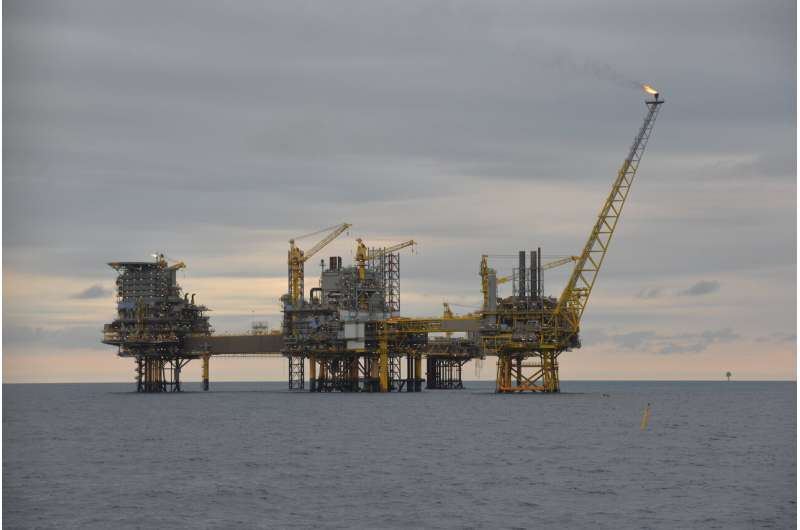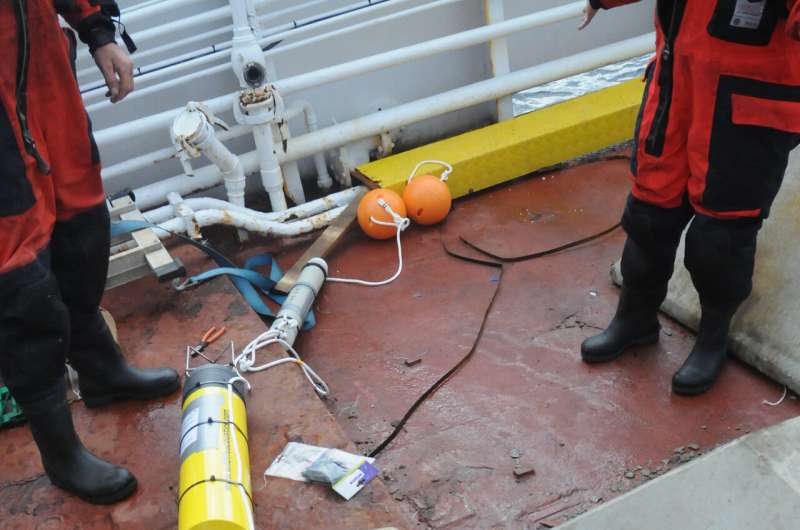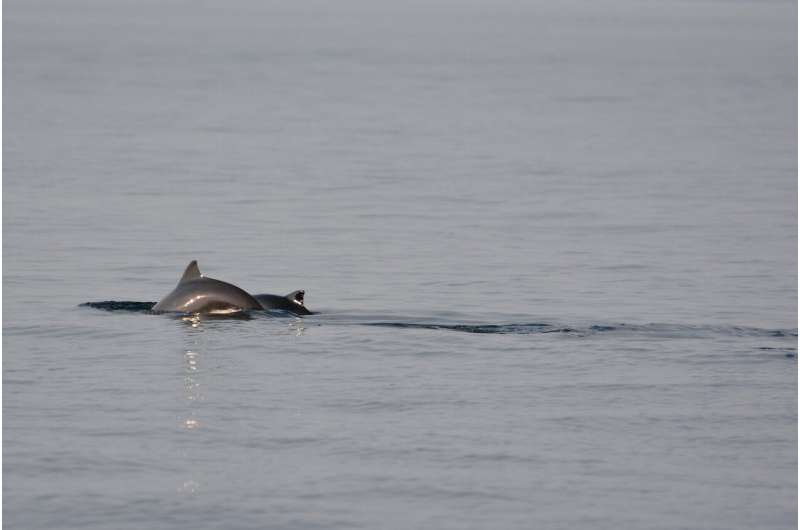The study site with the oil and gas platform Dan-F in the Danish sector of the central North Sea. To the right a small service vessel and a yellow buoy with autonomous acoustic recorders placed at the seabed, listening for harbour porpoises for two years. Credit: Jeppe Balle Dalgaard.
Large gatherings of fish tempt harbor porpoises to search for food around oil and gas platforms, even though the noise from these industrial plants normally scares the whales away. Decommissioned platforms may therefore serve as artificial reefs in the North Sea.
Harbor porpoises are among the smallest whales and the only whale that is known to breed in Danish waters. The harbor porpoise was protected in 1967 in Danish waters, and researchers from Aarhus University, Denmark, have previously shown that underwater noise from ships and seismic surveys of the seabed scare the porpoises away.
A new study now shows that in some parts of the year, there are actually more porpoises searching for food around the largest Danish oil platform, Dan F, in the North Sea than just 3 to 10 kilometers away from the platform.
21 listening stations in the North Sea
A team of researchers deployed 21 listening stations at the bottom of the North Sea. The innermost listening station was deployed immediately under the very large Dan F-oil and gas platform, while the outermost station was located 25.6 km away from the platform. One of the many listening stations was placed halfway between the inner- and outermost stations near the old oil well, Ragnar, which no longer produces oil.
The listening stations were left in the North Sea for two years to record all sounds below the surface of the sea, including the noise from ships and platforms, but also the sounds produced by porpoises for orientation and the so-called "buzz sounds" by which researchers can detect that whales are actively hunting for food.
"With this study, we're presenting the first investigation of the presence and feeding activity of porpoises throughout the year around oil platforms, as far as we know," says senior researcher Jonas Teilmann from the Department of Bioscience, Aarhus University, Denmark, who headed the investigations.
The new discoveries have just been published in the British journal Ecological Solutions and Evidence, and the results from the extensive data surprised the researchers.
A string with listening buoys is ready to be deployed in the sea. The bag, which is made of biodegradable hessian, is full of pebbles and serves as an anchor. From the surface, the researchers can acoustically release a hook to the anchors, bringing the recorders to the surface while the bags remain on the seabed where they dissolve. Credit: Karin Clausen.
Food attracts more than noise scares
"During the six months from July to January, we heard more porpoises searching for food around the two installations, the Dan-F platform and the Ragnar well, than we did in control areas located 6 and 25 kilometers away from Dan-F. This was even as high as the highest porpoise activity we have seen for Natura 2000 sites in the inner Danish waters," says Jonas Teilmann.
According to the researchers, the installations act as natural reefs where porpoises are provided with favorable living conditions as numerous species of plants and animals settle on the structures and provide hiding places and more food to the fish. Moreover, fishing is prohibited within a radius of 500 meters from the platforms why the seabed is undisturbed from trawling.
At the Dan-F platform, the researchers heard extensive activity by porpoises when searching for food up to 800 meters from the platform. In fact, the researches know that there were up to twice as many porpoises just below the platforms than recorded by the acoustic recorders as the noise from the platform will often drown the sounds made by the porpoises. Not until a distance of 12 kilometers from the platform, the noise disappeared.
The researchers cannot answer the question of whether the porpoises slowly get used to the noise from the drilling platforms, but it is clear that the motivation for finding food is greater than the deterrence effect of the noise.
"Our data show that the porpoises ignored the annoyance of the underwater noise to exploit the greater availability of food around the fixed installations," says Jonas Teilmann.
Porpoise mother with her calf. Credit: Jeppe Balle Dalgaard.
Should artificial installations be left in place?
During the period from July to January, it is important for the porpoises to consume as much food as possible in order to build up a solid layer of blubber that can sustain the animals through the cold winter. It is also during these six months that the mothers need energy to produce sufficient milk for their calves.
In contrast, the researchers found that there are far fewer porpoises searching for food around the artificial installations in the period from February to June.
"The signals from porpoises were far less frequent during this particular period, but the buzz sounds revealed that the porpoises still search for fish around the Dan-F platform and the Ragnar well from February to June. The noise from the platform is the same all year round, so we interpret the absence of porpoises as a change in the behavior or the presence of fish," says Jonas Teilmann.
The researchers recorded sounds from porpoises around the clock and could therefore hear that the whales were more actively searching for food at night than during the day, as far as 800 meters from the Dan-F platform.
This came as a surprise to the researchers, but they know that light lures zooplankton, squids and fish up into the upper water column at night. This initiates an efficient food chain that ends with the porpoises. This could explain why the Dan-F platform was especially attractive at night, while the day activity was higher at Regnar, where no light was present.
The OSPAR Convention, which protects the North Sea, requires that all decommissioned oil and gas installations are removed from the North Sea. However, the researchers now point out that the old installations may be left to serve as artificial reefs in the North Sea, the so-called "Rigs-to Reef" concept. Platforms and other installations can increase the diversity and biodiversity in areas that have been destroyed by trawling or where the original stone reefs have been removed and used for construction projects on land.
More information: Karin Tubbert Clausen et al, Echolocation activity of harbor porpoises, Phocoena phocoena , shows seasonal artificial reef attraction despite elevated noise levels close to oil and gas platforms, Ecological Solutions and Evidence (2021). DOI: 10.1002/2688-8319.12055
Provided by Aarhus University

























